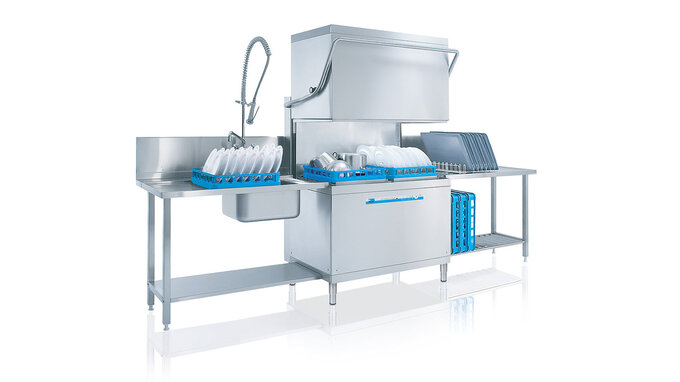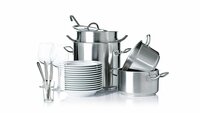CHOOSING A COMMERCIAL DISHWASHER FOR YOUR ESTABLISHMENT
What to take into account when choosing a commercial dishwasher
There are potentially many things to take into account when choosing a commercial dishwasher for your establishment.
Even if you have an existing commercial dishwasher which you are happy with, chances are since this dishwasher was purchased there have been many advances made in the types of commercial dishwashers and the features they offer.
Commercial dishwashers range in types from the very basic machines to the very advanced machines which also offer many years of good service, but can also offer substantial savings during the period usage and things such as insulation which make the machines quieter and help you save money.

SIZING THE COMMERCIAL DISHWASHER


It is quite a simple exercise to size a commercial dishwasher for a small to medium size establishment; however it does take some homework.
First consider and document the potential amount of plates, bowls, cups, saucers, glasses etc. which will require washing during your busiest work period. For a café, this could be breakfast, lunch or dinner. In an industrial complex, for example, it may be lunch when all the local businesses are staffed at their highest and are all looking for lunch or just a cup of coffee.
For example, say you have a 60 seat restaurant and you turn over each seat at least once and sometimes twice during dinner. Then you need to consider what most of the patrons eat. Do they all have entrée? Not always.
Once you have the figures in mind, you can then transfer them to the sizing chart. Our sizing chart gives a good indication on the amount of items that will fit into a 500mm by 500mm square basket (which is the industry standard for commercial dishwashers in Australia). From there you add a safety margin of around 10% and you have the estimated total number of racks to be washed during the dinner service. Then you to ask yourself in what amount of time do you want to be able to process these racks in.
To establish the amount of racks which need to washed per hour, divide the total number of racks by the time in hours. Once you have the total number of racks which need to be washed per hour, then you can select the appropriate commercial dishwasher to suit your needs.
Remember, the capacity normally stated on a commercial dishwasher brochure is a theoretical one as the manufacturers rate the machines off the running time in seconds, not necessarily allowing for any change over time in between racks. For example, if the shortest cycle on the commercial dishwasher is 60 seconds, the maximum (theoretical) capacity is 60 cycles an hour, or 1,080 plates (if loaded at 18 plates per cycle). Change over time is normally influenced by the area in which the operator is working and the amount of staff assigned to the area. For the sake of this exercise we will assume there is only one operator in the area.
If the area is well laid out, the change over time will be less. If you are not confident in establishing a change over time, use between 20 and 30 seconds per cycle. This would equate to a machine which has a 60 second cycle doing 40 cycles in an hour allowing for a 30 second changeover time. This may sound like a lot of time between cycles however there are many times when a rack is not ready to go straight into the commercial dishwasher and the operator also has to unload the clean items which are coming out of the machine.
THE SIZING CHART
| Quantity | Description (Quantity/No. Per Rack = No. of Racks) | No. Per Rack | Total No. of Racks | |
|---|---|---|---|---|
| Trays | Max length 450mm | 6 | ||
| 72 | Dinner Plates | Diameter 260mm | 18 | 4 |
| 88 | Side Plates | Diameter 160mm | 22 | 4 |
| 66 | Entrée Plates | Diameter 160mm | 22 | 3 |
| 48 | Soup Bowls | Diameter 160mm | 16 | 3 |
| 64 | Desert Bowls | Diameter 160mm | 16 | 4 |
| 125 | Coffee Cups | Diameter 85mm | 25 | 5 |
| 66 | Saucers | Diameter 160mm | 22 | 3 |
| 144 | White Wine Glasses | Diameter 75mm | 36 | 4 |
| 144 | Red Wine Glasses | Diameter 75mm | 36 | 4 |
| 108 | Beer or Soft Drink Glasses | Diameter 75mm | 36 | 3 |
| 40 | Serving Dishes | Max Length 450mm | 4 | 4 |
| 500 | Cutlery Laid out loose or in containers Approx. | 100 | 5 | |
| Plus Safety factor of 10%. | ||||
| Note quantities are indicative and depend on the depth of plates and the type of rack. | ||||
| TOTAL NO. Racks | 72 | |||
WHICH MACHINE SUITS MY ESTABLISHMENT?

Once you have sized the machine you need, then it is time to choose the commercial dishwasher that best suits your needs.
There are many factors which can influence this choice including,
- Cost
- Features & Benefits
- Size
- Required services
- Reputation
- Service Backup
- Warranty offered
- The wash up area
Let’s look at these one at a time.
Cost
As with most things, commercial dishwashers have a large range of models, makes and variations on the market. All of which have certain features which can vary the cost.
Features & Benefits
Over the last few years there have been tremendous strides made in this area. Some of these that are on offer include,
- Insulation which cuts heat in the area, stops the chance of the operators getting burnt from the door or hood and reduces energy loss, which in turn saves money.
- Reduced water usage due to more adequately designed rinsing systems, which not only save money on water & chemical usage but is also good for the environment.
- Water filtering within the machine to save time and also providing better results.
- Inbuilt chemical dosing equipment which gives you the freedom to choose your chemical supplier and also makes dosing easier.
- Electronic controls with many additional features.
Size
When replacing a commercial dishwasher that is built into a bench, it is advantageous to choose a new dishwasher with the same width to minimize alteration costs for the bench work. This could potentially save many hundreds of dollars. Also check the height to ensure the new dishwasher will fit under your bench or exhaust hood.
Required Services
As with size, if you are replacing an existing dishwasher, check what power, water and drainage services you have at the moment. Also consider if the commercial dishwasher is rated at over 8kw. If this is the case, you should have an exhaust hood built in over it to extract the air from the area or purchase a machine with an inbuilt condensation hood. Further, talk to your chemical supplier and ask them what is involved in connecting to a new commercial dishwasher and what if any costs you are looking at.

Reputation
If you are changing over a machine which has given you good service over many years, then this is a recommendation in itself. Ask around and seek advice. Talk to neighbouring businesses, as you may find one of them has just been through the exercise of changing their machine. Ask to speak to a few customers that have recently bought the same commercial dishwasher you are looking at.
Service Backup
Ask the dealer or supplier which services are available. This is particularly important if you are based in a remote area or country town. The least expensive may not be a good choice if there is no one trained on how to service it in your area. Ask what the most expensive parts are and how likely are they to fail. Also enquire about about spare parts availibilty for the commercial dishwasher you are considering.
If the model you are looking at is new to the market, then be vigilant as to how can it be repaired and what parts are in stock here in Australia.
Also check on what maintenance programs can be offered. Just like a car, dishwashers should be well maintained. Commercial dishwashers use water and heat it to a point where the water will undergo a chemical reaction. This can cause calcifying of elements within the machine, deposits in the wash chamber and in serious cases corrosion. If you are in a hard water area, you may need to consider some form of water treatment to protect the machine.
Warranty Offered
There are choices in the market on different warranties which you should look into. Some manufacturers or importers offer extended warranties and some also offer after hour warranties. Check what is covered by the warranty and just as importantly also what is not covered. Ask if the machine breaks down after hours (when most restaurants are operating at their peak) what is the cost to you and what does this cost cover?
The Work Area
The work area where the dishwashing is done has a big impact on the time taken and the results achieved. Ideally there should be a drop-off area for dirty plates and items to be placed after they are removed from the tables. There also needs to be an area for at least one rack which is to be loaded. Preferably there will be a sink with a pre-rinse spray mounted over it so the plates and bowls etc can be rinsed before they go into the dishwasher.
On the outlet of the machine should be an area for the unloading of the clean items and storage for the clean items once unloaded. Care should also be taken to help avoid “Cross Contamination”. This is when clean items are re-contaminated after being cleaned by crossing into a dirty area, or being handled by a person who is also handling dirty items. Therefore, there should also be good hand washing facilities within the wash up area, to help avoid this.
In Summary
As you can see there are many things to consider when looking to purchase a dishwasher. Fortunately, if it seems too daunting then you can contact a reputable dealer or supplier who is well versed in these matters.



